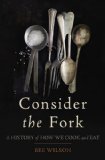Summary | Excerpt | Reading Guide | Reviews | Beyond the Book | Readalikes | Genres & Themes | Author Bio

Critics' Opinion:
Readers' Opinion:
First Published:
Oct 2012, 352 pages
Paperback:
Oct 2013, 336 pages
 Book Reviewed by:
Book Reviewed by:
Poornima Apte
Buy This Book
CONSIDER THE FORK
But for almost everything else, the politest way to eat was still with a fork. Among the English upper classes of the mid-twentieth century, the "fork luncheon" and the "fork dinner" were buffet meals at which the knife was dispensed with altogether. The fork was polite because it was less overtly violent than a knife, less babyish and messy than a spoon. Forks were advised for everything from fish to mashed potatoes, from green beans to cream cake. Special forks were devised for ice cream and salads, for sardines and terrapins. The basic rule of Western table manners in the nineteenth and twentieth centuries was: if in doubt, use a fork. "Spoons are sometimes used with firm puddings," noted a cookbook of 1887, "but forks are the better style."
Yet we have short memories when it comes to manners. It was not so long ago that eating anything from a fork had seemed absurd. As a kitchen tool, the fork is ancient. Roasting forks—long spikes for prodding and lifting meat as it cooks—have been around since Homeric times. Carving forks, to hold meat down as it is cut, are medieval. Yet forks for eating as opposed to forks for food preparation only started to seem a good idea in the modern era. The table fork is far less time-honored than such objects as the colander, the waffle iron, the bain-marie. In the great scheme of things, eating with prongs is a novelty.
n the parts of the world where forks are not used, they seem profoundly alien instruments—little metal spears that, unlike chopsticks or fingers, clash with food as it enters the mouth. Yet in the West, we use them so universally, we think nothing of them.
In the contemporary Western world, unless we are eating sandwiches or soup, almost every meal we eat now entails a fork. We use the fork to spear vegetables and to steady meat as we cut it; to pick food up or to chase it around the plate; to twirl spaghetti; to flake fish; to build up fragments of different foods into a single choice mouthful; or to hide pieces of unwanted cabbage from our parents' beady eyes. Children play with forks, using the sharp tines to reduce green beans to a mush, or to turn potatoes pink with ketchup. In a formal mood, we may even use a fork to eat a slice of cake, crumb by crumb. At fancy dinners or weddings, we still worry about which ornate fork to use for which course, but forks are also found at the most casual of meals, for the kind of basic snacks for which knives would be out of place. Office workers sit in the park eating pasta salad with a disposable fork, with half an eye on the crossword. Even kebab-eaters, reeling from the pub, will grasp a plastic fork to spare their fingers from the grease.
We take forks for granted. But the table fork is a relatively recent invention, and it attracted scorn and laughter when it first appeared. Its image was not helped by its associations with the Devil and his pitchfork. The first true fork on the historical record was a two-pronged gold one used by a Byzantine princess who married the doge of Venice in the eleventh century. St. Peter Damian damned her for "excessive delicacy" in preferring such a rarefied implement to her God-given hands. The story of this absurd princess and her ridiculous fork was still being told in church circles two hundred years later. Sometimes the tale was embellished. The princess died of plague: a punishment, it was said, for eating with a fork.
Six centuries later, forks were still a joke. In 1605, the French satirist Thomas Artus published a strange book called The Island of Hermaphrodites. Written during the reign of Henri IV, it made fun of the effeminate ways of the previous monarch, Henri III, and his court of mollycoddled hangers-on. In the sixteenth century, "hermaphrodite" was a pejorative term, which might be applied to anyone you didn't much like. In mocking these courtiers, one of the worst things Artus could think of was that they "never touch meat with their hands but with forks," whose prongs were so wide apart that the hermaphrodites spilled more broad beans and peas than they picked up, scattering them everywhere. "They would rather touch their mouths with their little forked instruments than with their fingers." The implication is that using forks was—like being a hermaphrodite—a kind of sexual abnormality. To Artus, the fork was not just useless—it was obscene.
Excerpted with permission from Consider the Fork: A History of How We Cook and Eat, by Bee Wilson. Available from Basic Books, a member of The Perseus Books Group. Copyright © 2012. Further information available at: www.considerthefork.com





The Funeral Cryer by Wenyan Lu
Debut novelist Wenyan Lu brings us this witty yet profound story about one woman's midlife reawakening in contemporary rural China.
Your guide toexceptional books
BookBrowse seeks out and recommends the best in contemporary fiction and nonfiction—books that not only engage and entertain but also deepen our understanding of ourselves and the world around us.